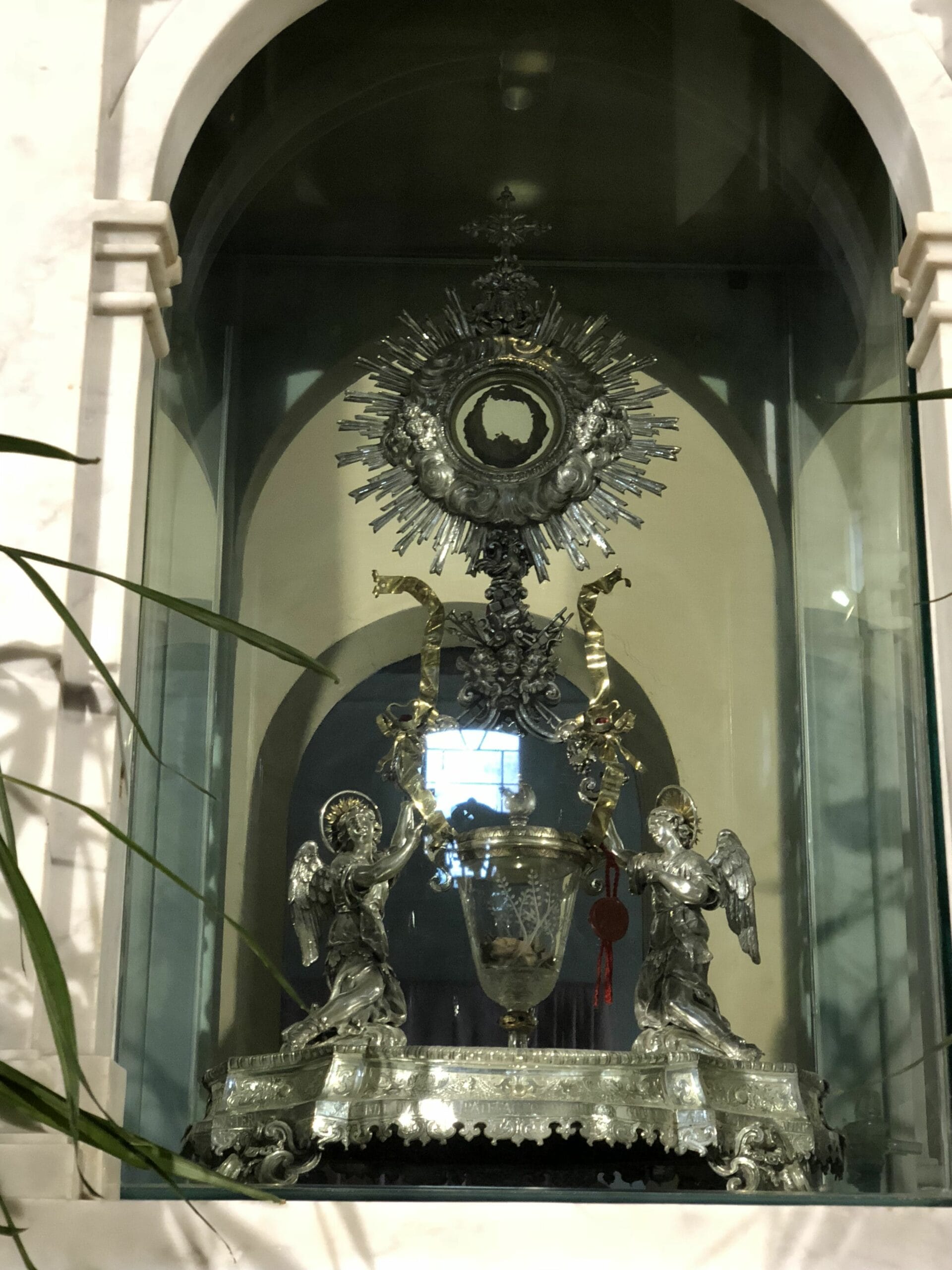This article explores the Eucharistic Miracle of Lanciano, a profound event intertwining faith and science. Journey with us to the 8th century, to the Church of St. Legontian in Lanciano, Italy, where a Basilian monk, wrestling with doubts about the Real Presence of Christ in the Eucharist, experienced a transformative event during Mass. The bread and wine he consecrated reportedly transformed into flesh and blood, forever altering his perception and igniting centuries of devotion.
The Transformation: From Doubt to Belief
The year is approximately 750 AD. Within the sacred confines of the Church of St. Legontian, a Basilian monk, plagued by doubts regarding the Real Presence, commenced the celebration of Mass. As he uttered the words of consecration, a profound transformation unfolded before his eyes. The bread and wine, symbolic representations of Christ’s body and blood, reportedly transmuted into actual human flesh and blood. Five irregular clots of blood materialized, further intensifying the awe and wonder surrounding the event. This extraordinary occurrence, known as the Eucharistic Miracle of Lanciano, became a cornerstone of faith for countless individuals and continues to inspire reverence today.
Scientific Inquiry: Unveiling the Miracle’s Nature
Centuries passed, and the narrative of the Lanciano miracle persisted, woven into the tapestry of religious tradition. Then, in the 20th century, scientific scrutiny was brought to bear on the relics. Between 1970-1971 and again in 1981, Dr. Odoardo Linoli, a distinguished expert in anatomy, pathological histology, chemistry, and clinical microscopy, led a team of scientists in a rigorous investigation. Their objective was to analyze the transformed elements, seeking to understand the nature of this enduring phenomenon.
Dr. Linoli’s research revealed astonishing findings. The flesh was identified as human myocardium, the muscular tissue of the heart. Microscopic examination revealed the presence of arteries, veins, and nerve fibers—all remarkably preserved despite the passage of over twelve centuries. The blood, upon analysis, was determined to be type AB, consistent with the blood type identified on the Shroud of Turin, a relic also believed to be connected to Christ. Discover a simple way to keep your kids engaged and create lasting memories with an editable elf on the shelf letter. Furthermore, the blood exhibited characteristics of fresh blood, containing intact proteins and minerals, defying the expected degradation over time. Notably, five distinct clots of varying sizes were observed, each possessing an equal weight when measured individually and collectively—an anomaly that deepens the enigma surrounding the miracle. These scientific observations provide an intriguing dimension to the Lanciano miracle, prompting further inquiry into the intersection of faith and scientific understanding.
Summary of Scientific Findings
| Element | Scientific Finding |
|---|---|
| Flesh | Human myocardial tissue (heart muscle) |
| Blood | Human blood type AB |
| Preservation | No preservatives detected, characteristics of fresh blood after 12 centuries |
The Relics Today: A Site of Reverence and Research
Today, the relics of the Lanciano miracle reside in the Sanctuary of the Eucharistic Miracle, located within the Church of San Francesco in Lanciano, Italy. The preserved flesh and blood are displayed for public viewing, encased in special reliquaries. The sanctuary serves as a focal point for pilgrims seeking spiritual solace and a testament to the enduring power of faith. Ongoing research continues to explore the miracle, inviting contemplation on the mysteries that lie beyond our current scientific grasp.
The “Biggest” Eucharistic Miracle: A Matter of Perspective
While Lanciano’s Eucharistic miracle is widely recognized, defining the “biggest” such event is subjective. Other notable instances include reported occurrences in Sokółka, Poland (16th century), Buenos Aires, Argentina (20th century), and Turin, Italy (home to the Shroud of Turin). Each event carries its own unique narrative and impact. However, Lanciano’s claim as the earliest documented and scientifically analyzed instance contributes to its prominence.
Notable Eucharistic Miracles
| Location | Approximate Date | Notable Features |
|---|---|---|
| Lanciano, Italy | 8th Century | Oldest scientifically analyzed instance, involving flesh and blood |
| Sokółka, Poland | 16th Century | A relatively early instance |
| Buenos Aires, Argentina | 20th Century | Modern occurrences investigated by scientists |
| Turin, Italy | Various | Home to the Shroud of Turin, a separate but related relic |
Determining the “biggest” miracle relies not on objective measures but on factors such as the number of witnesses, the duration of the perceived transformation, the extent of scientific investigation, the presence of physical evidence, and its impact on faith. While scientific analysis provides valuable insights into the physical composition of the relics, interpreting their significance remains deeply intertwined with individual beliefs. The Lanciano miracle invites contemplation on the interplay of faith and science, encouraging us to approach such phenomena with both wonder and critical inquiry. It reminds us that some questions may remain unanswered, even as we continue to explore the mysteries of faith and the limits of scientific understanding.
- Unlock Water’s Symbolism: A Cross-Cultural Exploration - April 20, 2025
- Identify Black and White Snakes: Venomous or Harmless? - April 20, 2025
- Unlocking Potential: Origins High School’s NYC Story - April 20, 2025















